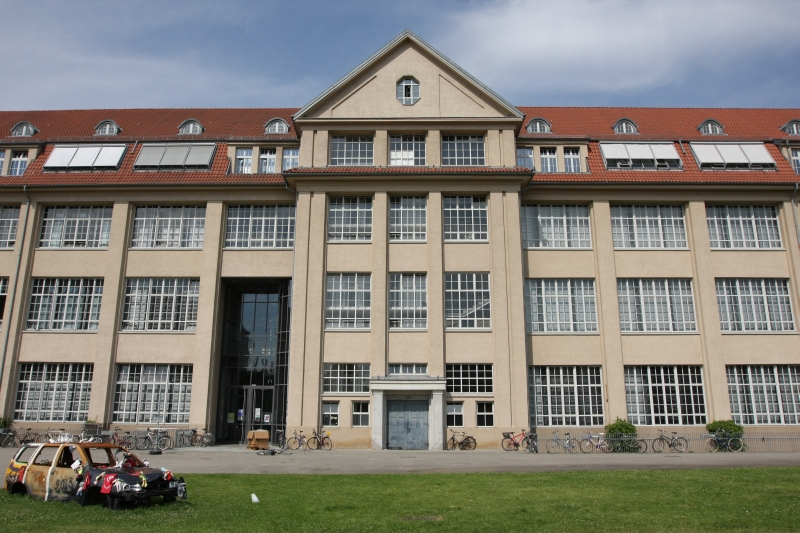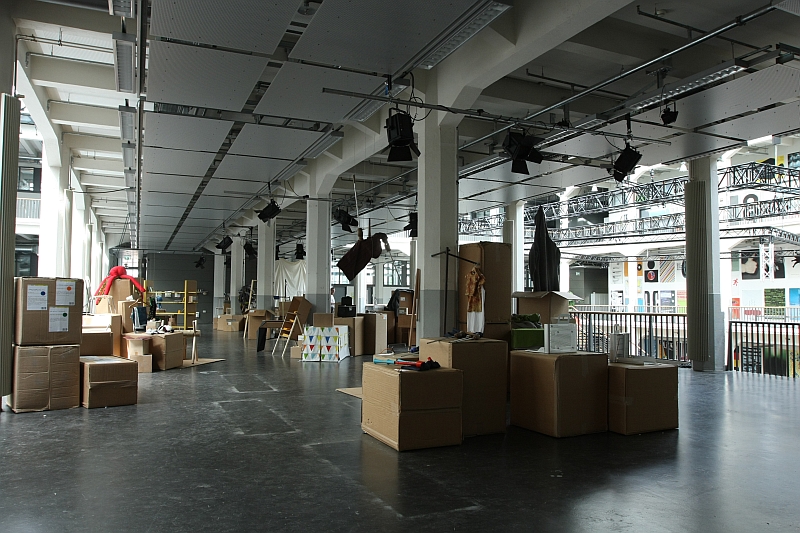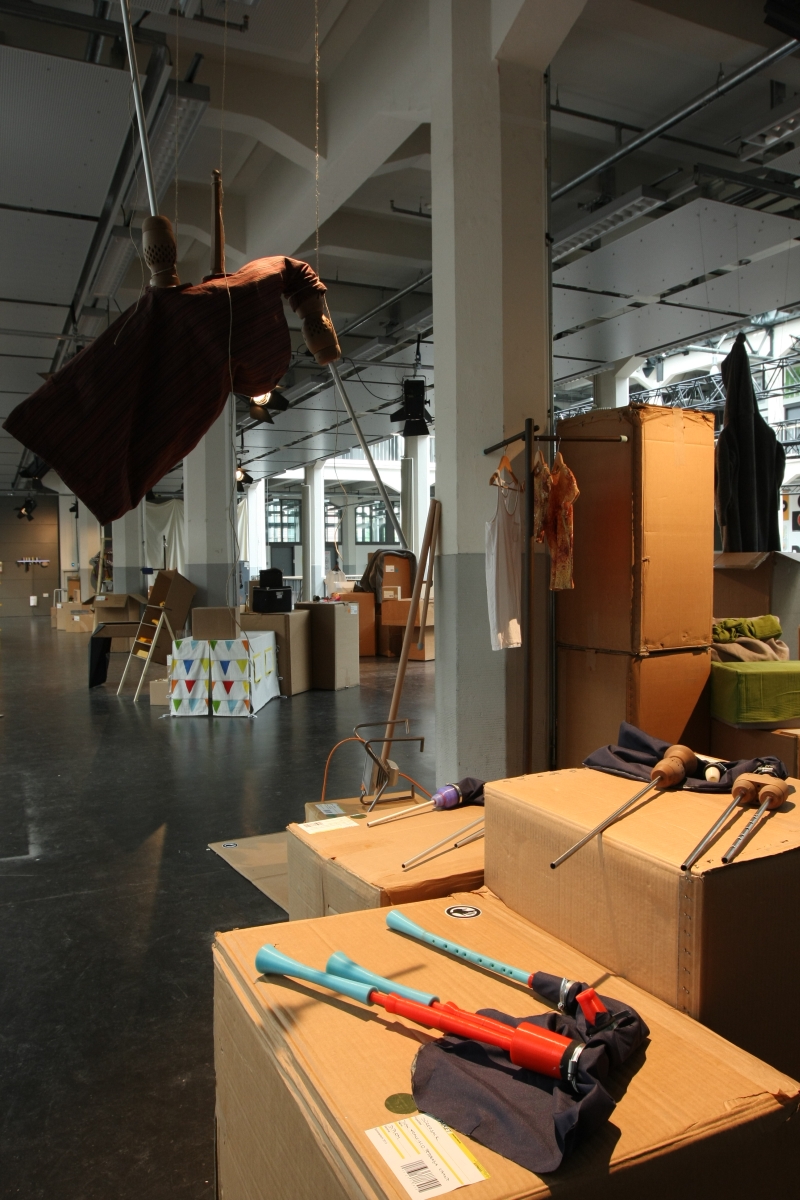The most ingenious aspect of the Hochschule für Gestaltung Karlsruhe is probably its location - sandwiched as it is between the Karlsruhe Centre for Art and Media with its research institutes, museums, galleries et al and Karlsruhe Job Centre..... Could there be a better metaphor for the precarious position of today's professional designer?
Probably. But we're sticking to ours.

Opened in 1992 the HfG Karlsruhe was established with the aim of creating an arts and design school for the modern age. There is, for example, no painting or sculpture classes in Karlsruhe, but they do offer media art or 3D modelling/animation alongside courses in, for example, communication design or product design. A key feature of the HfG Karlsruhe philosophy is the open nature of the teaching programme, or as Rector Peter Sloterdijk would have it, "The basis of learning and teaching at the Karlsruhe University of Arts and Design is pluralistic open-mindedness". And indeed whenever we speak to Karlsruhe students and graduates they invariably rave about the inter-disciplinary, practical nature of the study and the mixing of the year groups in project classes.
This open structure was very much in evidence at Sommerloch 2013 with works from numerous classes and students of different years mixed through each other.
Among the more interesting works on show were those from Prof. Volker Albus' "Move your Shelf" course and Prof. Stefan Diez's "K.O. Furniture" class; less on account of the works per se and much more because they underscored just how absurd the self-styled "trend researchers" mutterings about modern urban nomadicity truly are.
Mobility is an intrinsic feature of urban life. Always has been. Always will be. Demographic changes coupled to new technology and modern work practices may have focussed attention on the fact; but that doesn't mean it's new or on the increase. Just that it has moved into the lifestyle charlatans fields of vision. None of the objects presented in Move your Shelf or K.O. Furniture would fit into the popular ravings on the subject. But many were of a type that can ease urban mobility, support the real nomadicity and in their matter of factness swat down the jaded mantras, just like it was a fly. As Stan Ridgway would no doubt phrase it.
As we may have pointed out we have recently moved. Twice. Home and Office. It was a nightmare. Still is. Objects such as Case 66 x 33 by Franziska Rau and Josef Gawlik or XX by XX XXXX (unfortunately the student involved doesn't want us to mention the project. Which is a real shame because it really is something that deserves a wider audience) from the Move my Shelf class however beautifully demonstrate that it is possible to develop furniture which in the event of a flit can be transported with the contents in situ. Which gives us hope, eases the pain a little. Neither is anywhere near being a finished product, but both contained nice elements that, in our opinion, are worthy of further exploration. Similarly the spiritedly named "Arbeitstitle" by Marlene Deken and the even more spiritedly unnamed object by Anne-Sophie Oberkrome from the K.O. Furniture class still have a lot of development work ahead of them, and may ultimately not work, but both presented in their design approach interesting solutions for quick and easy tool-less shelf construction.

Back in January we missed, or better put, didn't have the time to visit, the "kkaarrlls für Echtwald" exhibition presented during Cologne Design Week. Fortunately Sommerloch 2013 provided an opportunity to rectify that.
The Echtwald Trust has set itself the aim of "renaturalising" forests, so moving away from commercial plantations and back to natural forests. To support this work they established a commercial arm that offers locally produced objects for sale, and in Cologne presented the first of a series of objects realised in cooperation with our favourite student platform, the HfG based kkaarrlls.
The obvious poster boy of the project is Tom Pawlofsky with his robotic chainsaw.
Technically the product is the 7xstool which Tom cuts directly from a tree trunk - with the aid of a chainsaw on the end of a robotic arm.
A robotic arm that as we say, does tend to steal the show.
And ultimately the project isn't even really about the stool, but the production process, the from Tom Pawlofsky developed software and the possibilities such robotic computer technology can offer traditional handwork.
One can view the project 3D Printed Woodwind by Juan Francisco Pedraza Kranz in a similar vein.
For his Diploma project Juan set about studying the possibilities of 3D printing, Open Design and the likes.
To this end he developed the physical representation of his research: a series of 3D printed bagpipes.
No honest.
All going to plan Juan will shortly release the files online, our hope is that a community grows around the files, ultimately resulting in a global 3D printed bagpipe orchestra. We'll keep you posted.
Further notable mentions must also go to Kitchen Shelf by Pia Matthes created as part of Stephan Diez's Masala Kitchen class, the project Bagshelf by Grischa Erbe and the truly sublime Louise lamp series created by Lisa Ertel in the context of a course looking for the next generation of Echtwald products.

The HfG Karlsruhe doesn't have it easy. Not only is the school in contrast to most other design schools in Germany relatively young, but Karlsruhe isn't the most alluring of locations for young creatives searching for adventure.
What does however speak for the school is on the one hand its relatively small size, something that creates a relaxed familiar atmosphere and on the other the quality, and for all the mix, of the teaching staff they can attract. In addition to the current "core" of Professors, including, Volker Albus, Stefan Diez and Hansjerg Maier-Aichen the Hochschule für Gestaltung Karlsruhe also regularly cooperate with designers such as Werner Aisslinger, Hannes Wettsein, Jerszy Seymour or Jurgen Bey.
That and, as already stated, the teaching philosophy, a philosophy that positively encourages students to think about their work in an inter-disciplinary fashion, or in the words of HfG Karlsruhe graduate Eva Marguerre, "My Diploma says “Product Design”, but my studies were much wider, which is good because product design shouldn’t stop when the product is finished."
And the HfG Karlsruhe students who understand that hopefully wont even notice the Job Centre on their doorstep.
A few impressions from the Hochschule für Gestaltung Karlsruhe Sommerloch 2013 exhibition: